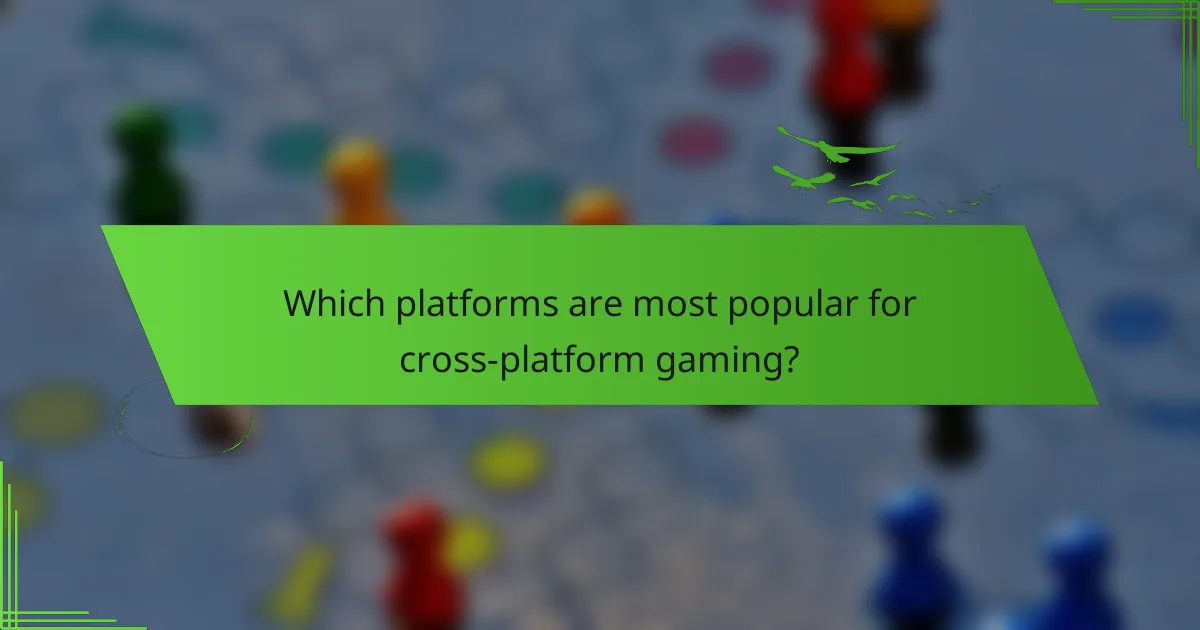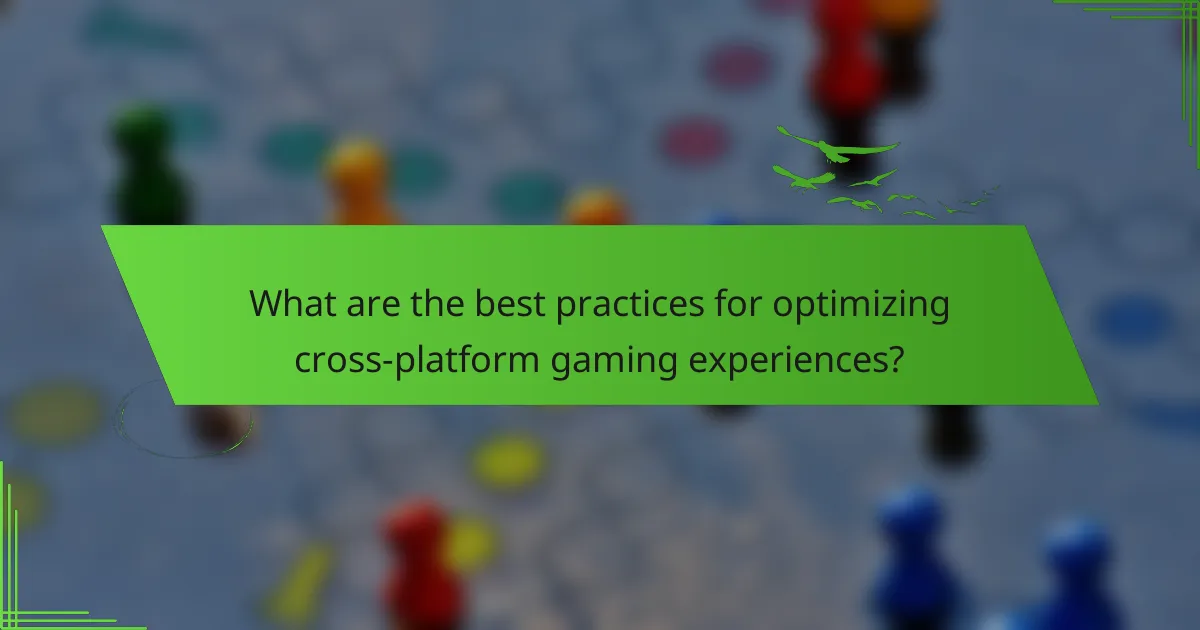Cross-platform gaming increases player accessibility and fosters vibrant community dynamics, allowing friends to connect regardless of their gaming systems. However, players face challenges such as technical issues and compatibility problems. This article explores the benefits of inclusivity and collaboration, the challenges that may arise, and the impact on community engagement across popular platforms like PC, Xbox, PlayStation, and Nintendo Switch.

What are the key benefits of cross-platform gaming?
Cross-platform gaming offers several key benefits, including increased player accessibility, enhanced community engagement, and extended game longevity. Players on different platforms can connect, fostering a larger and more diverse gaming community. This accessibility allows friends to play together regardless of their gaming system, improving social interaction and collaboration. Additionally, cross-platform functionality can sustain a game’s player base, reducing fragmentation and ensuring that games remain active for longer periods.
How does cross-platform gaming enhance player engagement?
Cross-platform gaming enhances player engagement by allowing users on different devices to play together. This inclusivity fosters larger, more diverse communities. Players can connect with friends regardless of their platform, leading to increased social interaction. Additionally, cross-platform functionality can extend the game’s lifespan by maintaining active player bases across various systems. This dynamic encourages developers to invest in ongoing content updates, enriching the gaming experience.
Which economic advantages does cross-platform gaming provide to developers?
Cross-platform gaming provides economic advantages to developers by expanding their market reach and increasing revenue potential. By allowing players from different platforms to interact, developers can tap into a larger audience, enhancing player engagement and retention. This approach reduces development costs by streamlining processes across multiple platforms, leading to higher profitability. Furthermore, cross-platform capabilities can foster a more vibrant community, which can drive ongoing revenue through in-game purchases and subscriptions.
What social benefits arise from cross-platform gaming communities?
Cross-platform gaming communities foster social benefits such as inclusivity, collaboration, and friendship. These communities break down barriers between different gaming platforms, allowing players to connect regardless of their hardware. As a result, gamers experience enhanced social interactions and a sense of belonging.
Players can collaborate on strategies and share experiences, enriching their gaming experience. This collaboration leads to the development of strong friendships, often extending beyond the gaming realm. Additionally, diverse perspectives from various platforms contribute to a richer gaming culture, promoting understanding and cooperation among players.

What challenges do players face in cross-platform gaming?
Players face various challenges in cross-platform gaming, including technical issues, compatibility problems, and differing player experiences. Technical issues arise from network latency and performance discrepancies across platforms. Compatibility problems can stem from different game versions or control schemes. Differing player experiences often result from variations in graphics quality and game mechanics. These challenges can hinder seamless interaction and enjoyment among players.
How do technical limitations affect cross-platform gameplay?
Technical limitations hinder cross-platform gameplay by affecting compatibility, performance, and user experience. Different hardware capabilities lead to disparities in graphics and frame rates. Network latency varies across platforms, impacting real-time interactions. Additionally, exclusive features on certain systems can create imbalances, limiting fair play. These factors can frustrate players and diminish the overall enjoyment of cross-platform gaming experiences.
What are the common issues with game balance across platforms?
Common issues with game balance across platforms include disparities in performance, control schemes, and player skill levels. These factors can lead to an uneven competitive landscape. For example, differences in frame rates may affect gameplay responsiveness, while varying input methods can create advantages or disadvantages. Additionally, community dynamics can influence perceptions of fairness, impacting player engagement. Addressing these issues requires continuous updates and player feedback to ensure a balanced experience.
How do player behaviors differ across platforms?
Player behaviors differ across platforms due to varying interfaces, community interactions, and game mechanics. Console players often prefer immersive experiences, while PC users may engage in competitive play. Mobile gamers typically seek casual, quick sessions.
Differences in social interactions also impact behaviors. Console platforms foster local multiplayer experiences, whereas PC gaming emphasizes online communities. Mobile games often feature social sharing and quick matchmaking.
Game mechanics vary by platform, affecting player strategies. Console games may focus on narrative-driven content, while PC games often allow for modding and customization. Mobile games frequently utilize touch controls, influencing gameplay styles.
Understanding these differences helps developers tailor experiences to specific audiences, enhancing player engagement and satisfaction.

How does cross-platform gaming influence community dynamics?
Cross-platform gaming enhances community dynamics by fostering inclusivity and collaboration among players. It allows individuals across different platforms to interact, share experiences, and form friendships, regardless of their gaming device. This connectivity strengthens community bonds and encourages diverse player participation.
Moreover, cross-platform gaming can lead to healthier competition as players from various backgrounds engage in shared gameplay experiences. As a result, communities become more vibrant and dynamic, reflecting a broader range of perspectives and strategies. This diversity can also drive innovation in gameplay and community events.
In summary, cross-platform gaming significantly influences community dynamics by promoting inclusivity, enhancing competition, and fostering a rich exchange of ideas among players.
What role do forums and social media play in cross-platform communities?
Forums and social media are essential in cross-platform communities, facilitating communication and collaboration among players. They provide spaces for sharing experiences, strategies, and updates, enhancing community engagement.
Forums allow for in-depth discussions, while social media offers real-time interactions and broader reach. This combination fosters a sense of belonging and encourages players to connect across different gaming platforms.
User-generated content on these platforms often highlights unique attributes of games, such as exclusive events or character customization options, enriching the overall gaming experience.
As a result, the synergy between forums and social media strengthens the dynamics of cross-platform gaming communities, driving participation and collaboration.
How does cross-platform gaming shape player interactions and friendships?
Cross-platform gaming enhances player interactions and friendships by breaking down barriers between different gaming systems. Players can connect regardless of their platform, fostering diverse communities. This inclusivity leads to increased collaboration and shared experiences, strengthening bonds among players. As a result, friendships often extend beyond gaming, creating lasting connections in real life.

Which platforms are most popular for cross-platform gaming?
The most popular platforms for cross-platform gaming include PC, Xbox, PlayStation, and Nintendo Switch. These platforms enable players from different systems to engage in multiplayer experiences.
PC gaming dominates due to its flexibility and extensive game library. Xbox and PlayStation have made significant strides with exclusive titles and robust online services. Nintendo Switch attracts a diverse audience with its unique hybrid design and family-friendly games.
The ability for players to connect across these platforms enhances community dynamics and broadens the gaming experience. This trend continues to grow as more developers embrace cross-platform capabilities, fostering inclusivity and collaboration among gamers.
What are the leading games that support cross-platform play?
Fortnite, Call of Duty: Warzone, Minecraft, Rocket League, and Apex Legends are leading games that support cross-platform play. These titles enhance player engagement by allowing users on different consoles and PCs to compete together.
Fortnite offers a unique building mechanic, while Call of Duty: Warzone integrates battle royale elements. Minecraft promotes creativity through its sandbox environment. Rocket League combines soccer with vehicular gameplay, and Apex Legends features diverse character abilities.
Cross-platform play fosters community dynamics by breaking down barriers between gaming platforms, enhancing social interactions and competition. This trend signifies a shift towards inclusivity in gaming experiences.
How do regional preferences impact platform choice?
Regional preferences significantly influence platform choice in cross-platform gaming. Factors such as local gaming culture, device availability, and community engagement shape user decisions. For instance, regions with strong mobile gaming communities may favor platforms that prioritize mobile access. Additionally, language support and regional game releases can enhance user experience, further steering platform selection. Understanding these dynamics is crucial for developers aiming to optimize their games for diverse audiences.

What unique features enhance the cross-platform gaming experience?
Cross-platform gaming enhances the experience through seamless gameplay, diverse player communities, and shared content. These unique features promote inclusivity and accessibility, allowing players from different platforms to connect. Enhanced matchmaking algorithms facilitate balanced gameplay across devices, improving competitiveness. Additionally, cross-platform support for in-game purchases and shared progress enriches user engagement and retention.
How do exclusive in-game events foster cross-platform participation?
Exclusive in-game events significantly enhance cross-platform participation by creating shared experiences among diverse players. These events encourage collaboration and competition, fostering a sense of community. Players from different platforms engage in the same challenges, leading to increased interaction and social connectivity. Additionally, unique rewards tied to these events motivate players to participate, regardless of their gaming system. This cross-platform engagement helps bridge the gap between communities, allowing for a richer gaming experience overall.
What innovative technologies are being implemented in cross-platform gaming?
Innovative technologies in cross-platform gaming include cloud gaming, blockchain integration, and advanced AI. Cloud gaming allows players to access games across devices without downloads. Blockchain enhances ownership and trade of in-game assets. AI improves matchmaking and player experiences.

What are the best practices for optimizing cross-platform gaming experiences?
To optimize cross-platform gaming experiences, developers should focus on seamless integration, consistent user interfaces, and robust server architecture. Effective communication across platforms enhances player engagement and satisfaction.
Implementing cross-platform play requires addressing unique attributes such as varying hardware capabilities and network stability. Regular updates and community feedback are essential for maintaining balance and performance.
Additionally, fostering a positive community dynamic through moderation and support can significantly improve player retention. By prioritizing these practices, developers can create a cohesive and enjoyable gaming environment across diverse platforms.
How can players improve their performance across different platforms?
Players can improve their performance across different platforms by optimizing their gameplay strategies, practicing consistently, and leveraging community resources. Adapting to each platform’s unique controls and mechanics enhances overall skills. Engaging with cross-platform communities fosters knowledge sharing and collaborative learning. Utilizing performance analytics tools can provide insights into areas needing improvement, while participating in cross-platform tournaments builds competitive experience.
What strategies can developers employ to enhance cross-platform functionality?
Developers can enhance cross-platform functionality by employing strategies such as using game engines that support multiple platforms, optimizing code for performance across devices, and implementing cloud-based services for data synchronization. These approaches ensure a seamless gaming experience regardless of the platform. Utilizing tools like Unity or Unreal Engine allows developers to create games that run efficiently on various systems. Additionally, adopting responsive design principles aids in adapting interfaces for different screen sizes and resolutions. Continuous testing across platforms is crucial to identify and resolve compatibility issues early in the development process.
What common mistakes should players avoid in cross-platform gaming?
Players should avoid common mistakes like neglecting communication, failing to understand cross-platform limitations, and not adapting to different control schemes. Effective communication is essential for teamwork, while awareness of technical limitations ensures smoother gameplay. Understanding various control schemes enhances performance and enjoyment across platforms.



